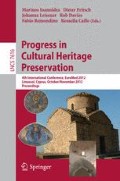Abstract
The future demands on professional archaeological prospection will be its ability to cover large areas in a time and cost efficient manner with very high spatial resolution and accuracy. The objective of the 2010 in Vienna established Ludwig Boltzmann Institute for Archaeological Prospection and Virtual Archaeology in collaboration with its nine European partner organizations is the advancement of the state-of-the-art by focusing on the development of remote sensing, geophysical prospection and virtual reality applications, as well as of novel integrated interpretation approaches dedicated to non-invasive spatial archaeology combining cutting-edge near-surface prospection methods with advanced computer science. Within the institute’s research program different areas for distinct case studies in Austria, Germany, Norway, Sweden and the UK have been selected as basis for the development and testing of new concepts for efficient and universally applicable tools for spatial, non-invasive archaeology. The collective resources and expertise available amongst the new research institute and associated partners permit innovative approaches to the archaeological exploration, documentation and investigation of the cultural heritage contained in entire archaeological landscapes. First promising results illustrate the potential of the proposed methodology and concepts.
Access this chapter
Tax calculation will be finalised at checkout
Purchases are for personal use only
Preview
Unable to display preview. Download preview PDF.
References
Gaffney, C., Gater, J.: Revealing the buried past: geophysics for archaeologists. Tempus (2003)
Conyers, L.B.: Ground-Penetrating Radar for Archaeology. AltaMira Press, Walnut Creek (2004)
Leckebusch, J.: Ground-penetrating Radar: A Modern Three-dimensional Prospection Method. Archaeological Prospection 10, 213–240 (2003)
Neubauer, W.: GIS in Archaeology - the Interface between Prospection and Excavation. Archaeological Prospection 11, 159–166 (2004)
Scollar, I., Tabbagh, A., Hesse, A., Herzog, I.: Archaeological Prospecting And Remote Sensing. Cambridge University Press (1990)
Becker, H.: Caesium-magnetometry for landscape archaeology. In: Campana, S., Piro, S. (eds.) Seeing the Unseen – Geophysics and Landscape Archaeology, London, pp. 129–165 (2009)
Trotzig, G.: The new European Convention on the Protection of the Archaeological Heritage. Antiquity 67(255), 414–415 (1993)
Powlesland, D.: Redefining past landscapes: 30 years of remote sensing in the Vale of Pickering. In: Campana, S., Forte, M. (eds.) From Space to Place: Proceedings of the 2nd International Conference on Remote Sensing in Archaeology, Rome. BAR Int. Series, vol. 1568, pp. 197–201 (2006)
Doneus, M.: Vertical and oblique photographs. AARGNews 20, 33–39 (2000)
Doneus, M.: Precision Mapping and Interpretation of Oblique Aerial Photographs. Archaeological Prospection 8, 13–27 (2001)
Devereux, B.J., Amable, G.S., Crow, P., Cliff, A.D.: The potential of airborne lidar for detection of archaeological features under woodland canopies. Antiquity 79, 648–660 (2005)
Doneus, M., Briese, C.: Full-waveform airborne laser scanning as a tool for archaeological reconnaissance. In: Campana, S., Forte, M. (eds.) From Space to Place: Proceedings of the 2nd International Conference on Remote Sensing in Archaeology, Rome. BAR Int. Series, vol. 1568, pp. 99–106 (2006)
Gaffney, C., Gaffney, V., Neubauer, W., Baldwin, E., Chapman, H., Garwood, P., Moulden, H., Sparrow, T., Bates, R., Löcker, K., Hinterleitner, A., Trinks, I., Nau, E., Zitz, T., Floery, S., Verhoeven, G., Doneus, M.: The Stonehenge Hidden Landscapes Project. Archaeological Prospection 19, 147–155 (2012)
Trinks, I., Johansson, B., Gustafsson, J., Emilsson, J., Friborg, J., Gustafsson, C., Nissen, J.: Efficient, large-scale archaeological prospection using a true three-dimensional ground-penetrating Radar Array system. Archaeological Prospection 17(3), 175–186 (2010)
Grasmueck, M., Weger, R., Horstmeyer, H.: Full-resolution 3D GPR imaging. Geophysics 70, K12–K19 (2005)
Author information
Authors and Affiliations
Editor information
Editors and Affiliations
Rights and permissions
Copyright information
© 2012 Springer-Verlag Berlin Heidelberg
About this paper
Cite this paper
Trinks, I., Neubauer, W., Doneus, M. (2012). Prospecting Archaeological Landscapes. In: Ioannides, M., Fritsch, D., Leissner, J., Davies, R., Remondino, F., Caffo, R. (eds) Progress in Cultural Heritage Preservation. EuroMed 2012. Lecture Notes in Computer Science, vol 7616. Springer, Berlin, Heidelberg. https://doi.org/10.1007/978-3-642-34234-9_3
Download citation
DOI: https://doi.org/10.1007/978-3-642-34234-9_3
Publisher Name: Springer, Berlin, Heidelberg
Print ISBN: 978-3-642-34233-2
Online ISBN: 978-3-642-34234-9
eBook Packages: Computer ScienceComputer Science (R0)

